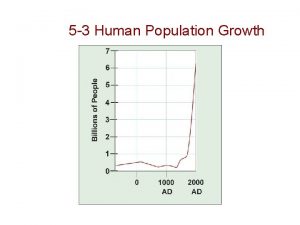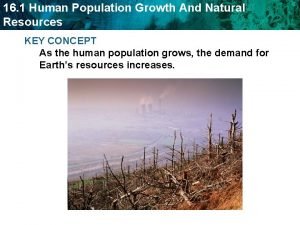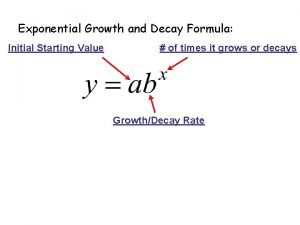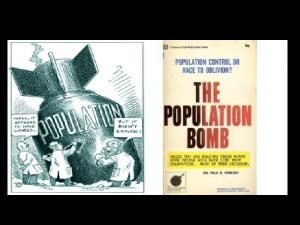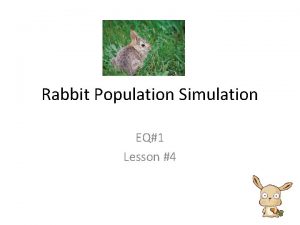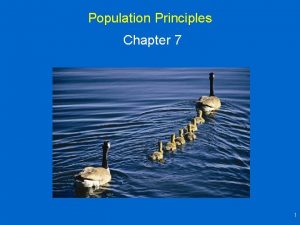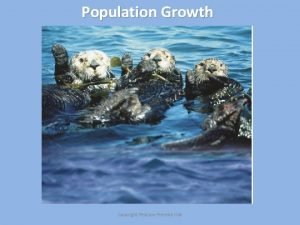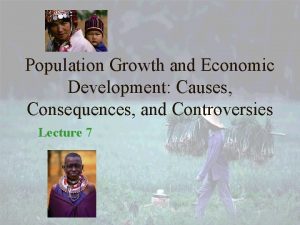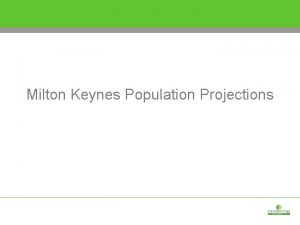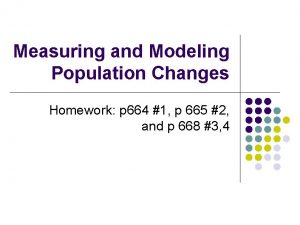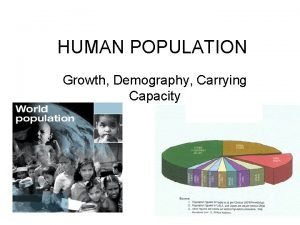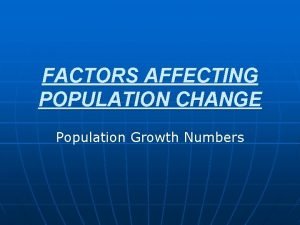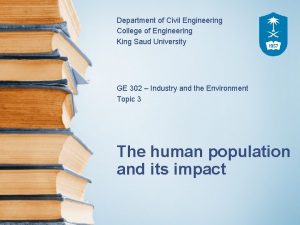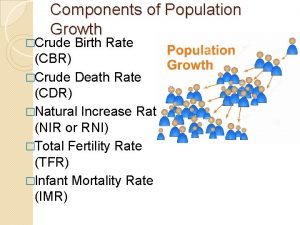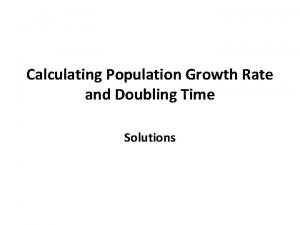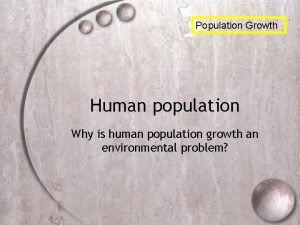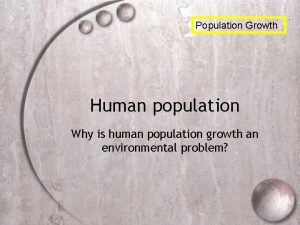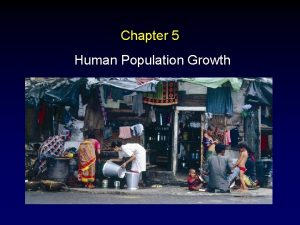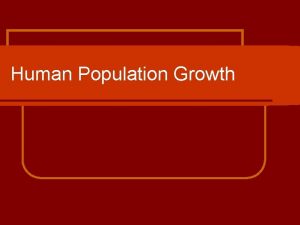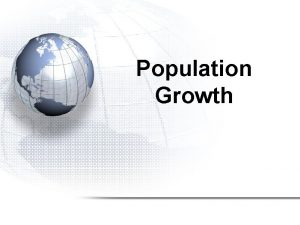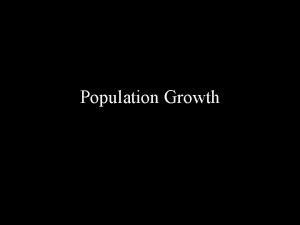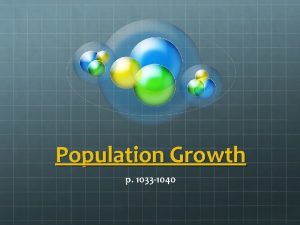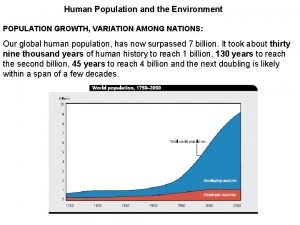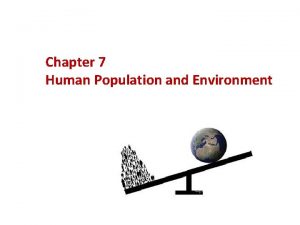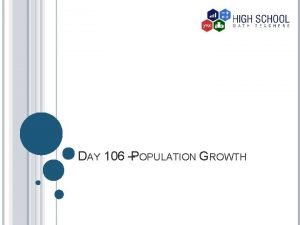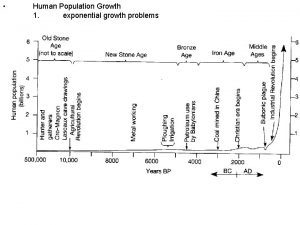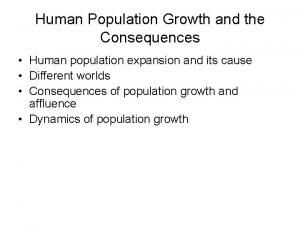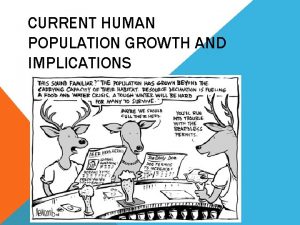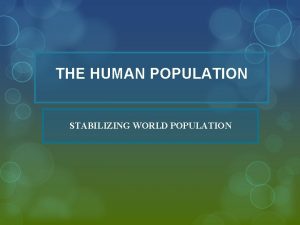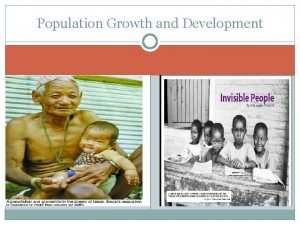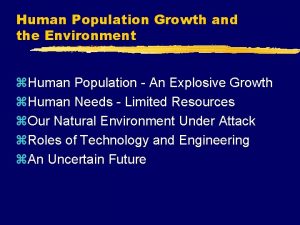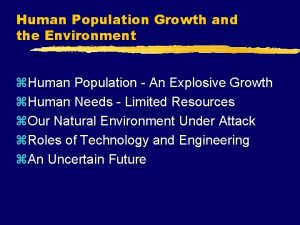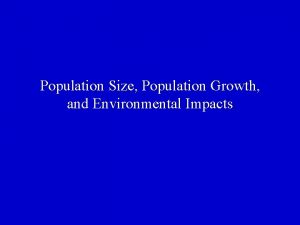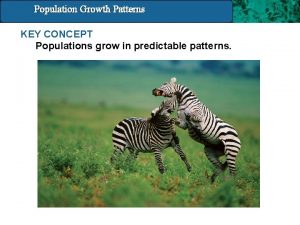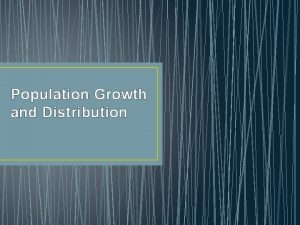Human Population Growth and the Environment z Human






























- Slides: 30

Human Population Growth and the Environment z. Human Population - An Explosive Growth z. Human Needs - Limited Resources z. Our Natural Environment Under Attack z. Roles of Technology and Engineering z. An Uncertain Future

World Population Growth Billions Through History 12 11 2100 10 9 Old Stone 7 Age 8 New Stone Age Bronze Age Iron Age 6 Modern Age Middle Ages 2000 Future 5 4 1975 3 1950 2 1 Black Death —The Plague 1+ million 7000 6000 5000 years B. C. 4000 B. C. 1900 1800 3000 2000 1000 A. D. B. C. 1 1000 2000 3000 4000 5000 Source: Population Reference Bureau; and United Nations, World Population Projections to 2100 (1998).

Humans are Recent Arrivals z Earth - 5 Billion Years z Multi-cell Biota 600 Million Years z Human Beings ~ 2 Million Years z Human Population Growth into Billions - Last 200 years 66 Billion A Million Years Of Human Growth (1)

A Closer Look z 12, 000 years (1) z 2, 000 Years The Industrial Revolution 1 Billion 200 million z 200 Million by 1 A. D. z 1 Billion in 1800 A. D.

Three Technological Eras z (2)

What’s Behind Population Growth z Three Factors y. Fertility y. Infant Mortality y. Longevity z Animal Domestication and Agriculture y. Provided for a few to feed many z Industrial Revolution y. Growth of Cities and Infrastructure x. Water x. Energy x. Transportation y. Increased Productivity y. Nutrition y. Sanitation y. Medicine

Fertility Trends z Population predictions are very sensitive to future fertility assumptions z At 1990 fertility rates (constant by region) population would grow to 110 billion in 2100, over 700 billion in 2150 (3) z Has been dropping since 1800 in developed nations - now at Zero Growth (4) z Is on its way down in much of the developing world (4)

Population Predictions z Most predictions: 9 -12 B by 2050 1015 B by 2100 z UN (Low) requires global fertility at less than zero growth in 15 years z Large uncertainties (4)

Population May Overshoot When Population Outpaces Resources Scenario - current population trend, doubled resources (5)

Resource Consumption z High consumption z Getting worse z Rate increase faster than population growth (6)

Resource Limits - Land z Deforesting to acquire more arable land z Would run out in next century at current yields z Probably need to double yields (7)

Resource Limits - Water z In 1950 people used half of accessible water z Are now dependent on dams z Pollution loses 33% of potential water z Getting close to limits (8)

Energy Consumption z Energy growth very high last fifty years z Mostly hydrocarbon fuels z Nonrenewable resource consumption and climate change issues (9)

Fossil Fuel Reserves (9) • Lots of coal - but heavy CO 2 contributor • Look for alternative forms of energy to emerge

Technology Evolves (10) • Cars replaced horses as transportation needs grew • Energy forms have changed to meet changing needs • New economic and environmental needs are emerging

Economics and Resources (11) 1. 1 billion people suffer from malnutrition z Impact = P*A*T 84. 7 % of global income y. Population y. Affluence y. Technology z US - 5% of global population but 20 -25% of environmental impact 1. 4 Poorest 20% Richest 20%

Planet Earth is Impacted (12) z. Ecological Footprints y. United States - 5 hectares/person y. Developing nations - 0. 5 hectare/person z. For everyone to live at today’s US footprint would require 3 planet Earths z. Increasing affluence and population is damaging Earth’s essential ecology

z. Process of Globalization – LPG (Liberalization-Privatization-Globalization) z. Promotion of FDI ( Foreign Direct Investment) in SEZ ( Special Economic Zone) z 100 % FDI in Oil Exploration and Petroleum Products, . Natural Gas related sectors z. Infrastructure Development with the help of PPP and DOT z Triggered industrial growth

Global Warming - A Good Example z Atmospheric CO 2 is increasing, and creates greenhouse effect. (14) z 3 -5°C rise predicted by computer models for this century would have major environmental impact. (15) z Observed change of 0. 25 -0. 4°surface and 0. 0 -0. 2°C troposphere rise in last 20 years doesn’t agree with models and may or may 0. 6°C rise in last 100 years not be due to CO 2. (16) z Humans - 6 billion tons/year of CO 2 (up 500% from 1950, and increasing) (17) y Other sources 200 B tons/year y Total atmosphere load - 775 B tons y Total earth load with oceans - 42, 000 B tons

Global warming: melting of snow / thermal expansion of water and rise in sea level

Our ‘Commons’ are in Danger z. Atmospheric pollution and climate change z. Water pollution, including ground aquifers z. Deforestation and loss of oxygenation z. The oceans, coral reefs and their bounty z. National parks, wildernesses and wetlands z. Nonrenewable natural resource depletion y. Fossil fuels, mineral ores, topsoil…. .

Desertification: Causes and its effects Causes • Accelerated Population Growth • Increased cultivation with intensive and extensive methods • Massive Deforestation for timber or mining, cultivation, industrialization, urbanization other projects • Over grazing Effects Loss of top soil cover and diminishing organic nutrients, increase in infertile soils and barren lands, decrease in food production, food insecurity, mal-nutrition and starvation, loss of green cover and environmental problems

Biodiversity is in Danger (13) z. Humanity has spawned a species extinction to rival the 5 great extinctions of 65 - 440 million years ago z. Recovery times from the great extinctions took 10’s of millions of years z. Biodiversity is essential to life on Earth and holds untold treasures for the future z. An ecological ethic is emerging

The Effects of Global Warming on Land animals z Global warming can disrupt the migration, hibernation and reproductive cycles of certain types of animals. z Plants and animals will find it hard to escape or adjust to the effects of warming because humans occupy so much land. z Farmland or cities interrupt the movement of species between habitats. z Ecosystem is disrupted leading to ecological disequilibrium as a result wild animals entering the human settlements for their survival.

Acidification of Oceanic waters and bleaching of coral reefs

Melting ice and rising sea level Receding high mountain glaciers Ice shelves of the South Pole have partly separated and are collapsing. (NASA)

Predicting the Future - Be Careful • Don’t assume it cant be done • Leave room for the unknown • Consider alternatives carefully • Pursue all potential solutions

Technology’s Roles z. Detailed explicit information and understanding of what is occurring y. Sensors, data processing, computers, models, predictions, communication, information…. . . z. Alternate technologies that mitigate and eliminate deleterious effects y. Energy, water, transportation, communication… z. Sustainable Development

Engineers are vital z. Developing and applying ythe means by which to measure, analyze and predict future conditions ythe technologies by which to mitigate and eliminate undesired effects z. Describing, explaining and communicating y. To policy makers y. To the non-technical public z. Creating the framework for a sustainable environment

Summary z. Major increases are occurring in human population and affluence. z. Major stresses result in our society, natural environment, and ecology. z. Technology and engineering are central to the creation and the mitigation of problems. z. Predicting the future is difficult (17). The next twenty five to fifty years will be decisive.
 Population growth concept map answers
Population growth concept map answers Section 5-3 human population growth
Section 5-3 human population growth Natural resources and population growth
Natural resources and population growth Rate of growth or decay
Rate of growth or decay Absolute growth rate and relative growth rate
Absolute growth rate and relative growth rate Monocots vs eudicots
Monocots vs eudicots Primary growth and secondary growth in plants
Primary growth and secondary growth in plants Primary growth and secondary growth in plants
Primary growth and secondary growth in plants Chapter test a chapter 4 population ecology answer key
Chapter test a chapter 4 population ecology answer key Population ecology section 1 population dynamics
Population ecology section 1 population dynamics Population ecology section 1 population dynamics
Population ecology section 1 population dynamics Population ecology section 1 population dynamics
Population ecology section 1 population dynamics Rule of 70
Rule of 70 What are the two types of population growth
What are the two types of population growth Modeling population growth rabbits answer key
Modeling population growth rabbits answer key Population growth curve
Population growth curve Copyright
Copyright Geometric vs exponential growth
Geometric vs exponential growth Why population growth is good
Why population growth is good What is population ecology
What is population ecology Logistic growth ecology definition
Logistic growth ecology definition Milton keynes population growth
Milton keynes population growth Biotic potential
Biotic potential Rule of 70 in population growth
Rule of 70 in population growth Pre reproductive age
Pre reproductive age Population growth factors
Population growth factors Population growth differential equation
Population growth differential equation Fertility rate decline
Fertility rate decline Military base population pyramid
Military base population pyramid Logistic model of population growth
Logistic model of population growth How to calculate population growth rate
How to calculate population growth rate

